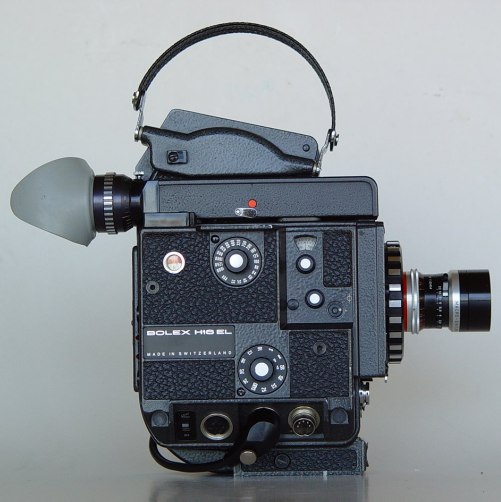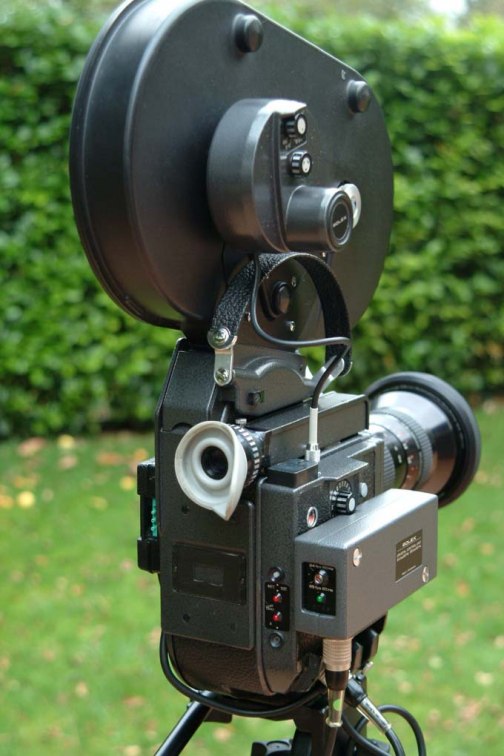Bolex H16 User
For Practical Bolex H16 Filming
H16 EL
Bolex Product Code:- 210.065 Bolex H16 EL camera body, without lens, supplied with 1 NiCd-battery 12V / 0.8 Ah 1 Charger 110-120V or 220-230V (specify voltage when ordering), 1 Electric release cable, 1 Set of 4 filter holders
 The
Bolex EL has all the usual Bolex features we've grown to love such as
automatic film threading, loop forming and spool ejectors to eject the
spools off there spindles when needing to reload. It is also slightly
quieter than the other Bolex cameras.
The
Bolex EL has all the usual Bolex features we've grown to love such as
automatic film threading, loop forming and spool ejectors to eject the
spools off there spindles when needing to reload. It is also slightly
quieter than the other Bolex cameras.
The standard frame and footage counters are still in place and the reflex viewfinder comes as standard offering 13x magnification. It also has the by now new standard 1:1 Drive shaft but has dropped the old 8:1 shaft which all the old cameras had.
Behind the lens filters are now fitted by removing the lens and fitting filter material between two plates of a round plastic disk which is then screwed in behind where the lens would sit. So you have to remove the lens to switch or alter the behind the lens filter material. The filter material has to be cut in a round disk between a diameter of 38mm and 40mm across.
The major feature enhancement of the EL is the built in light meter that uses a light sensitive cell that moves into the central axis behind a lens when a button is pressed to measure light directly through any taking lens.
 Using
a pair of LED's that only both light when the correct f stop on the lens
has been set based on the fps speed and the film speed. The cell is automatically
withdrawn as soon as you start filming or a minute after you pressed the
light meter button.
Using
a pair of LED's that only both light when the correct f stop on the lens
has been set based on the fps speed and the film speed. The cell is automatically
withdrawn as soon as you start filming or a minute after you pressed the
light meter button.
The film chamber door has slots to enable the attachment of an external battery. The EL is not designed to be used with the Powergrip so requires it's own custom battery.
There are two types of battery pack available for the EL the standard pack weighing 13oz gives 600ft continuous run. The heavy Duty pack gives 2000ft continuous run. The packs can be charged on slow trickle charge for 14 hours or rapid charge for half an hour.
On the picture on the right you can see on the left of the camera the battery with a wire snaking from the left side of the camera to the right where it plugs in to power the camera. On the right side of the camera you can see that screwed into it using two screw threads is the Bolex Crystal Control Unit.
| Bolex H16 EL Data Table | |
| Variable Shutter | No |
| Lens Mount | Bayonet |
| Shutter Angle | 170° |
| Filming Speeds in fps | 10, 12, 18, 20, 24, 25, 32, 40, 50, +Single Frame |
| Behind the lens Filter | Yes |
| Reflex/Non Reflex | Reflex |
| Backwindable | Yes |
| Frame Counter | Yes |
| Drive shaft for external electric motor drive | Yes 1:1 Type |
| Round/Flat Base | Flat Base |
| Magazine Mount | Yes |
Unlimited reverse run of 100ft camera spools at 18fps is possible. What this means is that if your half way through exposing a 100ft camera spool of Kodak 7218 at night and now you want to switch to 7245 in the day well now you can! and much more easily than using the spring based cameras. On the older cameras you would have to rewind film using the tiny backwind handle painfully through x amount of feet to rewind all the film back onto it's spool if you wanted to change films mid way through a roll.
 I'm
unsure as to whether you can use the backwind facility for in camera trick
effects like superimposition but i think it would work by using a combination
of reverse and forward wind to get the film into exact positions dictated
by using the frame counter while the lens was covered then uncovering
to shoot another scene.
I'm
unsure as to whether you can use the backwind facility for in camera trick
effects like superimposition but i think it would work by using a combination
of reverse and forward wind to get the film into exact positions dictated
by using the frame counter while the lens was covered then uncovering
to shoot another scene.
However you would be unable to do fades and dissolves. You cannot actually film shots backwards using this backwind utility and you are still unable to rewind film using the 400ft magazine attached as the take up motors WM and MM only work one way.
There were 3 Different types of EL made with only slight differences between them. They have been named as Series 1, 2 & 3. Series 1 was introduced in 1975 and is distinguished by not having two screw threads on the side of the camera that you can use to screw the accessory Crystal Control unit into.
So that's how to tell if you have a series 1
or not! Series 2 and 3 both have these screw threads to tell them apart
look at the ASA dial if it goes up to 1600ASA you have a Series 3 if it
only goes to 500ASA you have a Series 2. ![]()
Series 2 Introduced in 1978 also got a TV 4:3 mask in the viewfinder, LED battery power indicator with instant stop and a clapper lamp switch. Series 3 Introduced 1980 had all of series 2's improvements as well as light meter increased ranged (mentioned earlier) and a device for locking film speed and ASA dials to prevent them from being accidentally moved.